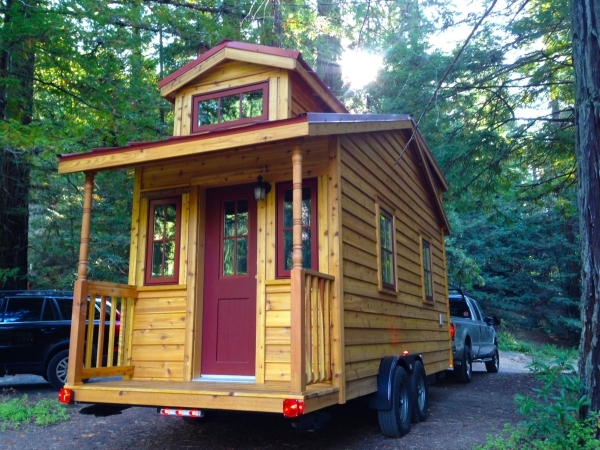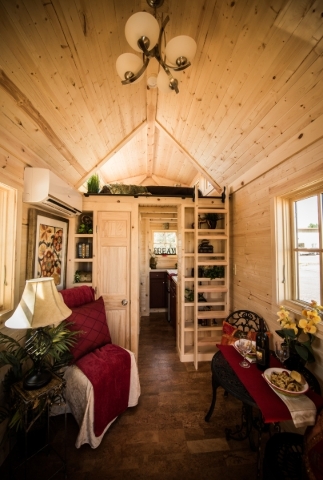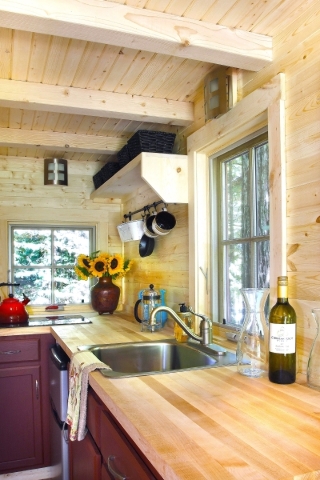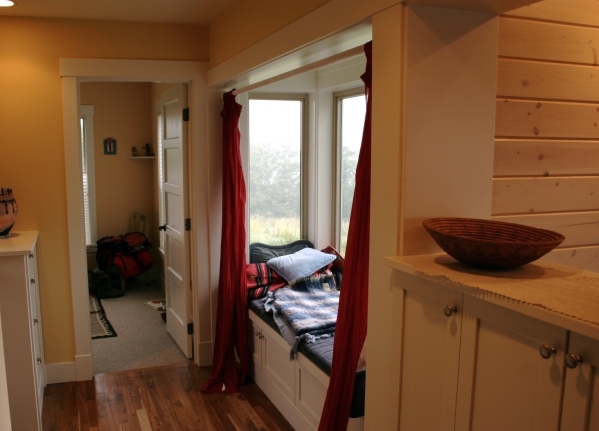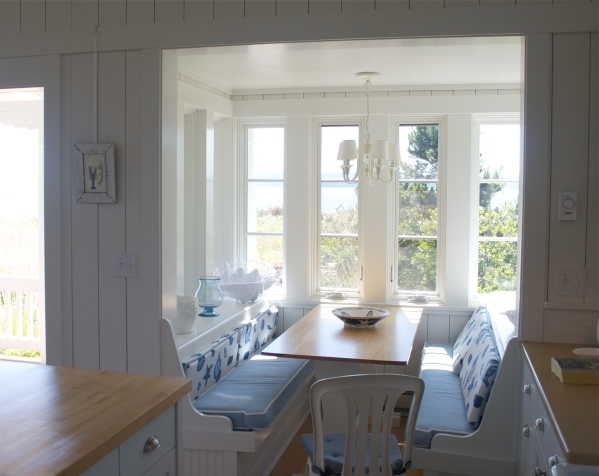Tiny houses prove size doesn’t matter
Jeff Wilson no longer needs a potato masher or a cherry pitter. These kitchen junk drawer items are the casualties of an emerging new life — one that will soon involve living in a tiny 184-square-foot home constructed on a 20-foot trailer.
Wilson and Megan Masching, both long-time Cirque du Soleil managers, are more than half way finished with their future home. They're happy with their growing cut-list that extends far beyond potato mashers and cherry pitters.
"I feel better as we get lighter," Masching said of the thinning-out process she and Wilson are currently going through.
But the couple, along with other tiny house enthusiasts, asserts that while scaling back on belongings is part of the experience, there are plenty of other design, layout and everyday living takeaways from the tiny house movement that can be applied to any home.
The itch to go small
In February 2014, Masching and Wilson attended a Las Vegas workshop conducted by Tumbleweed Tiny House Co., which creates and markets tiny house floor plans. The couple had been mulling the idea of a tiny home after realizing how little of their 1,600-square-foot rental house they actually used.
After the workshop, they purchased a trailer and Tumbleweed's Linden Overlook 20 floor plan, then began constructing their new home in a friend's backyard. They plan to live in it full-time when finished.
The average newly built single-family home in America tops 2,400 square feet, according to 2015 U.S. census figures. Tiny houses, sometimes referred to as "micro" houses, tend to be only a few hundred square feet or less. There also are small homes that can fall into the 500 to the 1,200 square foot range, explained Ross Chapin, a Langley, Wash.-based architect who has devoted most of his career to creating small homes and unique neighborhoods for them.
"It's not so much square footage as it is usage," he said.
The architect talks about a "livability quotient" with his clients. For example, a 3,000-square-foot home where only 1,500 square feet is used daily has a 50 percent livability quotient, while a 300-square-foot space that is used completely, every day, has a 100 percent livability quotient.
"There's a sweet spot for everyone, and that's the size that works for you," he added.
Tony Hsieh, Zappos.com CEO and founder of the Downtown Project, is a proponent of the small house movement. He created the Airstream Park, a 1-acre lot of trailers and Tumbleweed cabins, located near the Container Park on East Fremont Street. Hsieh, in fact, lives in one of the silver Airstreams.
In December, HGTV launch "Tiny House Hunters," the most recent incarnation of the cable network's "House Hunters" franchise. "Tiny House Hunters" tracks homebuyers on the hunt for super-small homes. Buyers choose among three houses they tour during the show.
Multiuse items
At the core of living in a tiny house or smaller home, is the need for multiuse items and furnishings. Masching and Wilson's home is essentially 7½ feet wide by 18 feet long. For the main family room area, they are considering a modular couch that can also serve as a dining room table or chez lounge.
"If it only does one thing and nothing else, it's probably gotta go," Wilson said when discussing the thinking beyond choosing everything that goes into his tiny home, from utensils to furniture.
Not everything, however, will be micro-sized. The kitchen will have a full-sized sink purchased from Ikea and an induction cooktop, but only a toaster oven and a smaller refrigerator. Sites like compactappliance.com, and others, offer downsized appliance options. The couple has also opted against having a washer and dryer.
"Laundry night will be date night," Wilson added, with a laugh.
Ross Beck, operations manager for Tumbleweed Tiny House Co., says when it comes to furnishing tiny homes, the focus is on quality items, not quantity.
"Most people come at it with an attitude of wanting to go small, but they want high-quality things," Beck added. "They want to live tidy and have a real emotional response to the things they do have."
He also sees tiny house owners who still opt for granite counters and full-sized refrigerators.
"It really comes down to their interests. If they love to watch movies, they will have a large HD screen hung on the great room wall and surround sound," he noted.
Beauty meets utility
When it comes to tiny, or smaller, homes, Chapin says it's about creating small spaces that "live well." He calls the family room "the life of the house" that is often used 100 percent of the time. If you're designing a smaller home, he, and Beck, share these key insights.
Think of halls as interior rooms, not simply walkways from one place to another. Chapin creates sitting areas, cut-ins, bay window seats and alcoves in hallways.
Guest rooms can be created from small areas at the top of a stairway or in small open spaces that may otherwise be an empty landing or unused space.
Some interior walls can be designed to be thicker and include pocket spaces or shelves for televisions to hang and books to be stored. Beck also says tiny house owners will tuck closets under stairways, even drawers under individual stairs.
Unique outdoor living areas often complement small homes. Avoid "key-fumbling porches," Chapin adds. Make room-sized porches that provide privacy but invite conversation with neighbors.
Decorating
Wilson, Masching and Chapin shared the following decorating insights, too.
For tiny houses, avoid dark-colored walls, Wilson said. He and Masching will use dark, contrasting items in their home.
In smaller homes, one room may borrow visual space from another, Chapin said, and raised ceilings can allow the space from one room to flow into another.
Windows, especially in tiny houses, are a necessity on all sides of a home to maximize light. And smaller homes also will often have windows that extend closer to the floor and up to the ceiling, Chapin explained.
If you're looking to make a hallway look bigger, a window at the end of a hall adds extra light and can bring the perception of more space.
"I look at a design choice as a chance to increase the magic of the home," Chapin said. "If you, for example, add a seat in a bay window, it doesn't add a whole lot of cost, but it adds a whole lot of magic."
Thinking it through
If you're thinking of designing or building a smaller home or tiny house, Masching and Wilson say it's important to tap outside resources. The couple has dealt with its share of supply ordering problems and construction challenges with their $35,000 investment. They have created a tiny house meet-up group to share ideas with others.
"It's amazing how if you tell people what you need, they can be so helpful. There's an amazing amount of support out there," Masching said.
Before jumping into a project, Chapin encourages people to create a journal, first. Use the home refrigerator as a place to collect ideas, too. Cut them out of magazines or other media sources, he said.
He encourages people to pose the question: "How does my house live?" Think of different times of year — the summer, the holidays, the start of the school year, for example — and how areas of your current home are used during those periods.
"I think this tiny house conversation can be an inspiration. It may not fit how you live, but it gets you thinking about how you live," he added. "If you can bring these questions up and help people think more deeply about them, that's a good thing."



